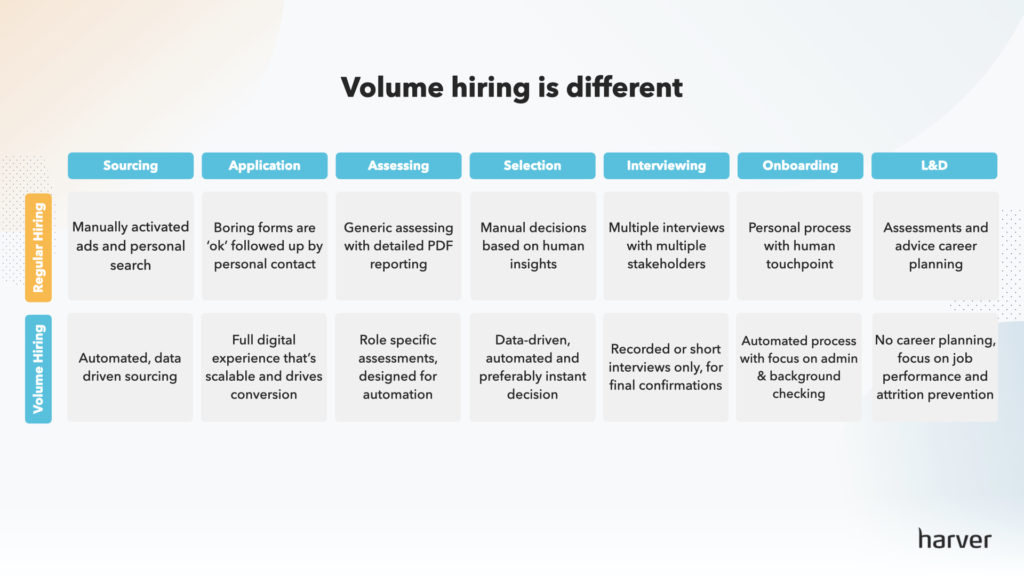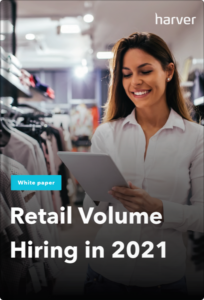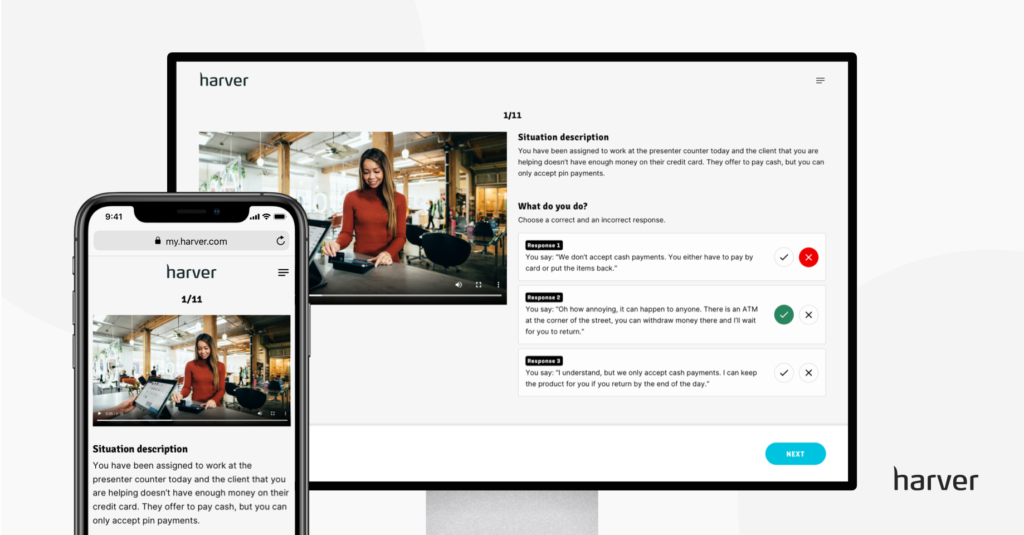Retail is an industry that typically relies on volume hiring for entry-level jobs. With busy seasons in the summer and winter, bringing on a large number of employees to handle the influx of shoppers is necessary.
But when it comes to recruiting for these positions, most retail companies rely on a decentralized model. Each store location is responsible for hiring its own staff. And in some ways, this process makes sense; every store manager knows what they need and what they don’t, and they know the local labor market well. They’re able to make the right decisions for themselves without needing to depend on headquarters.
But decentralized recruiting isn’t always the best method. In fact, it often leads to a fragmented process that negatively impacts not only the hiring managers but the candidates and headquarters alike.
Let’s dive into the specifics of hiring for retail to understand why centralizing recruitment makes more sense from a business point of view.
What’s in?
What are the disadvantages of decentralized recruiting?
When you start to look more closely at decentralized recruitment methods, some clear disadvantages appear. Here are some of the biggest drawbacks of decentralized recruiting for retail hiring managers, candidates, and headquarters.
Disadvantages for hiring managers
When each location is responsible for its own hiring, recruiters and hiring managers lose visibility into the existing talent pool. They’re only able to see candidates who apply to that specific location — not the high-quality candidates applying to the location on the other side of town.
If that more popular location doesn’t have the space for all the great candidates who apply to the open position, the company could miss out on great applicants.
Also, the more recruiters you have, the more likely it is to deal with hiring bias, as not everyone uses the same criteria or has the same standards when evaluating an applicant’s profile. So the bigger your talent team, the bigger the risk of bias in the hiring process.
Disadvantages for candidates
A decentralized process can also be disruptive for candidates. If each location has a different application process, candidates who want to apply to more than one location might have a confusing experience that deters them from following through with the application.
Lack of connectivity and communication between locations also means candidates who get rejected from one location will need to start the interview process from scratch if applying at a different store.
Drawbacks for headquarters
Decentralized recruiting can be costly for headquarters as it reduces the amount of data they have on hand, and doesn’t provide full visibility into the stages of the process that are less efficient. When it comes time to hire new employees, recruiters need to start the process from zero every time. And in volume hiring, costs add up quickly.
Also, with a decentralized approach, the risk of inconsistencies in processes and tech stack is high. When every location uses different software or different procedures for sourcing, screening, assessing, and selecting candidates, keeping costs under control can quickly become a challenge.
Not to mention that it’s much harder for a company that operates in multiple locations to showcase a consistent brand image and to keep track of D&I initiatives when hiring is decentralized. So this makes employer branding and building a diverse workforce more challenging as well.
What is a centralized recruiting process?
Where in a decentralized recruiting process each store gets to set its own hiring system, a centralized recruiting process creates consistency across all locations.
Centralized recruiting uses a standardized process that evaluates candidates based on the same set of criteria, regardless of the location they applied to. Recruiters use the same tools and candidates have the same experience.
For hiring managers, a centralized recruiting process automates some of the processes. This frees up their time, allowing them to focus on other tasks. It also makes it easy to hire candidates from other locations, such as if a candidate is moving to another city. Because all locations have the same hiring process, hiring managers can understand that past employees meet the qualifications.
Candidates receive a uniform experience and have the chance of being rerouted to a location with more job demand if rejected from the store they originally applied for. This increases their chances of getting a job and makes it easier for them to apply.
Headquarters also benefits from a centralized recruiting process. There is more flexibility for scaling up and down processes as demand changes, resulting in more cost savings and increased productivity. Another benefit is being able to adopt automated tools like automated recruiting chatbots that conversationally engage and screen candidates to minimize drop-off.
With these in mind, let’s look at some best practices for moving from a decentralized to a centralized recruitment strategy.
Like what you see?
Don’t miss out. Subscribe to our monthly digest to get the latest TA and TM resources delivered right to your inbox.
7 best practices for centralized recruitment
If you’re ready to get started with a centralized recruiting process, here are seven best practices to keep in mind.
1. Choose a recruitment software built for volume hiring
Before you can have a truly centralized recruiting process, you need software that makes it easy for all locations to connect and communicate with one another. This means your first step is to choose your tech stack.
However, this choice should be made with the specific challenges of retail volume hiring in mind. For example, in regular recruitment, sourcing candidates manually is not necessarily a problem, but when hiring at scale, you can’t afford to go after each candidate one by one, so you need a tool that enables you to optimize your sourcing strategy.
The same applies to the selection stage: while screening CVs and going through the results of pre-employment assessments manually is not such a big problem in regular hiring, when dealing with high-volume recruitment, such tasks can take a lot of time.

You should therefore choose a solution that is designed for volume hiring. Your recruitment platform should keep an overview of all your talent, candidates per location, and the status of all applications. Also, it should allow you to collect all the candidate and process data in one place, so you can analyze it and gather insights more efficiently.
Finally, you should choose a recruiting tool that provides a unified experience for the candidates, while enabling you to showcase your company culture. With this tech stack, you can maintain branding consistency and ensure standardization across your various locations.
Harver checks all these boxes, so if you’d like to see our retail volume hiring software in action, you can book a demo below.
Ready to transform your hiring process?
2. Standardize your hiring process and workflows
Selecting the right recruitment software is just the start. In order to offer a uniform experience to both candidates and hiring managers across locations, you need to establish standardized processes and workflows that can make the process smoother.
Think of all the various processes a hiring manager must bring the candidate through. From applying to the job to screening, selection, skills assessments, and interview scheduling, you’ll want to set clear guidelines, expectations, and criteria for each phase.
Setting standardizations can create guidelines that ensure each hire fits the company culture and has the skills and characteristics needed to do the job well.
At Harver, we help our clients in streamlining their recruitment strategy by facilitating a series of workshops before the solution design phase. During these workshops, we look at the current hiring processes to identify the bottlenecks, and we map all the touchpoints to understand how both the recruiters and the candidates experience the process.
Once that is clear, we start designing the ideal picture, taking into consideration not only the process steps but also the assessments used for selecting candidates and the matching criteria for the different types of roles available.
Stop guessing,
Start data-driven hiring.
Learn how you implement a modern candidate selection process, that is: streamlined, experience-driven and backed by data.

3. Automate manual tasks
One of the biggest benefits of a centralized recruiting process is that it allows for automation. When you can automate some of the steps and processes, you’re able to take work off your hiring managers’ plates that allows them to focus on more important tasks.
Recruitment automation for retail also makes it easier to remain flexible and to scale up and down as necessary. As busy seasons come and go, you can easily adjust your recruitment process to accommodate the influx of applicants and hires without additional stress on your hiring managers.
Look for all opportunities to automate tasks, but keep an eye on how things go. Just setting and forgetting your automation can lead to mistakes that let great quality candidates fall through the cracks. Automation is a great tool for helping you find high-quality candidates but always use your best judgment.
For example, you can start smaller and automate screening of retail candidates, or you can implement an end-to-end digital hiring solution that automates the entire process, from sourcing and screening to assessing candidate skills, selecting applicants, and scheduling interviews.
A platform like Harver, which is built for high-volume hiring, can work alongside your ATS, automating the manual steps of the process and the tasks that don’t require real-time human judgement. Below you can see an example of solution design in which most of the recruitment tasks are taken over and automated by Harver.

4. Reroute candidates when appropriate
After a candidate has applied to a job and deemed a good fit for the company, you can reroute them to a location where they’re needed. When they apply to a position using a centralized recruiting process, require that they let you know what locations they’re interested in. You can then use rerouting software to disperse candidates where the demand exceeds the supply of applicants.
Rerouting is a great way to make sure less visible stores are still getting high-quality candidates. When everyone applies to one centralized location, you can hire the best candidates across the board — not risk losing great employees because they applied to a very popular location.
This is a great step to automate. Because store managers already have a lot on their plate, automating this process can ensure it is done effectively and on time. Moving the recruiting process along quickly can prevent top candidates from getting hired somewhere else while your managers are busy.
We’ve detailed this topic in the article below.
5. Share expertise
With a decentralized hiring process, each store is on their own for hiring and managing talent. When processes aren’t standardized, they can’t ask headquarters or another location for help because employees may not meet the same qualifications.
But when hiring processes are standardized across the company, hiring managers and store team members can better support one another because they speak a common language. They were all hired under the same criteria, so it’s easy to connect with other stores, team members, managers, and even headquarters for help.
This can also come in handy if a particular location is busy or understaffed. If there is another store with employees capable of doing the same job, they can pick up a few shifts at the understaffed store and ensure things run smoothly until more hires are made.
- White paper
Before you continue!
Don’t forget to grab your free copy of our new white paper on the digital transformation of retail volume hiring. Learn about:
- The challenges currently shaping the retail volume hiring space
- How to align your recruitment strategy with today’s reality by adopting technology
- The four building blocks of a fully digital recruitment process

6. Track the right metrics
In order to improve your hiring process and make focused, data-driven decisions for maximum impact, you need to know which recruitment metrics are relevant and impact your bottom line. Now that you have a standardized process and a tool that collects all of your data, you have new insights into the information you need to make hiring decisions stronger.
Take a look at how your recruitment methods are impacting your business overall. Where do your best employees come from? This insight helps you optimize your sourcing strategy by prioritizing the channels that consistently supply better candidates.
Then, what skills do your top performers have? If you look at the profiles of your best employees, what do they have in common? And how are you assessing these skills when hiring new employees? Standardize and centralize this process, to maintain consistency when hiring and make sure you select the right people for your current and future needs.
What can you do to bring more of these kinds of candidates on board? Use analysis and reporting to constantly improve your recruiting process and your bottom line.
The Harver platform, for example, offers a powerful BI suite and a series of out-of-the-box dashboards that provide insights not only into your sourcing and recruitment efficiency but also into how inclusive your hiring practices are and how happy candidates are with the application experience.

7. Hire for skills, not for roles
When recruiting candidates in retail, you want to hire candidates who have transferable skills. When candidates are hired for their skills and not for specific roles, it’s easier to move them around when something unexpected happens (like 2023’s rampant inflation and economic downturn).
While it’s hard to try and have employees capable of tackling every problem on staff, transferable skills give you flexibility you need to adapt when something goes wrong. Hiring for skills can help you get through a crisis.
When an interested candidate applies for a job, think about how they can fill in gaps in your staff that you might have at the moment. Sure, they need to be able to do the job you’re hiring them for, but what unique abilities do they bring to the table?
At Harver, we help our retail clients who deal with volume hiring for entry-level jobs build custom application flows by combining out-of-the-box pre-employment assessments with situational judgment tests designed specifically for retail.
The entire application process is built around our two-way matching framework which on the one hand enables companies to showcase their culture and the work environment, and on the other hand, enables candidates to self-select out of the process if they don’t like what they see.
During the application process, candidates are offered a realistic job preview, to understand what the role they’re applying for actually entails. This helps in managing their expectations for the job and in reducing the early attrition of new hires due to misaligned expectations.

Avoid centralizing your final decisions
Centralizing your hiring process is a great way to make recruiting for retail more efficient. But at the end of the day, each store is going to understand their unique needs more than headquarters or a centralized hiring department. For this reason, store managers should have a final say in who is hired.
Use centralization as a method of getting high-quality candidates to all of your store locations. It can vet them, interview them, and make sure they’re a good fit for the company overall, but then hand the decision over to your store manager to determine whether or not that individual is right for the store’s position.
If you’re interested in learning more about our solution for centralizing volume recruiting in retail and how Harver can support you, book a demo below.

